Menus
- Water cooling on Harley’s top tourers
- More performance thanks to water cooling
- This is how the Harley-Davidson Electra Glide Ultra Limited drives
- Sound without smoke: the "Boom! box"
- Revisions to the chassis
- Data and measured values
- MOTORCYCLE measurements
- Technology: water cooling in the legendary air-cooled V2
- Interview with the Marketing Director Frank Klumpp
- MOTORCYCLE points evaluation and conclusion
- Conclusion
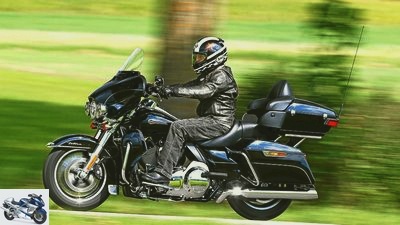
Gargolov

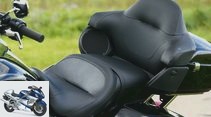
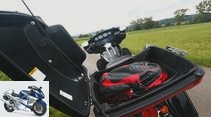
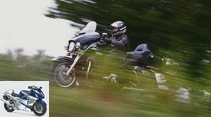
24 photos
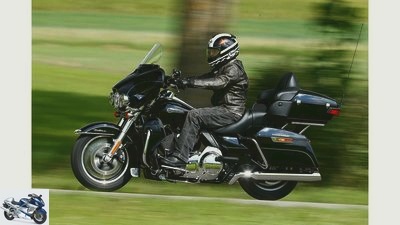
Gargolov
1/24
The 2014 E-Glide has become a beauty.
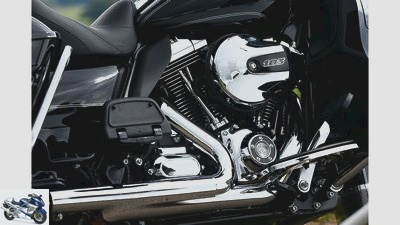
Gargolov
2/24
The air / water-cooled two-cylinder four-stroke 45 degree V engine from the E-Glide Ultra Limited.
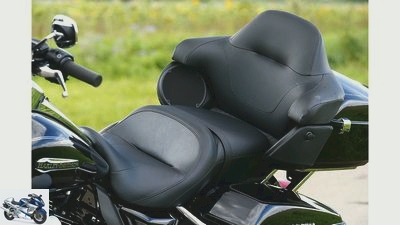
Gargolov
3/24
Seat and pillion.
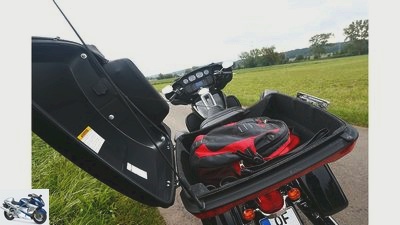
Gargolov
4/24
The E-Glide offers additional storage space.
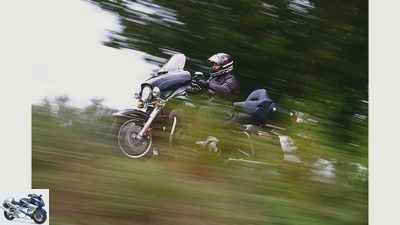
Gargolov
5/24
The new model is not only optically but also technically equipped for the future.
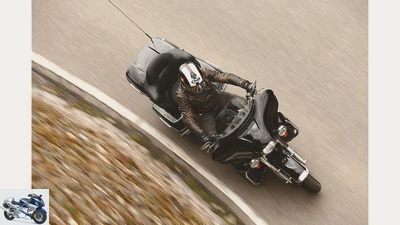
Gargolov
6/24
In good hands: it sits snuggly behind the batwing panel
and pleasantly relaxed.
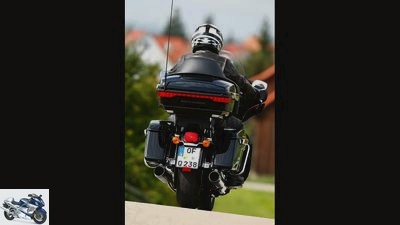
Gargolov
7/24
The E-Glide also makes a stocky impression from behind.
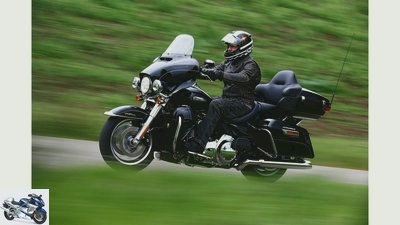
Gargolov
8/24
Once in motion, the 412 kilograms of US heavy metal can be controlled surprisingly easily.
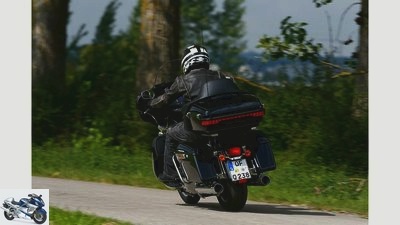
Gargolov
9/24
New top case: more aerodynamic and beautiful with integrated brake and rear lights.
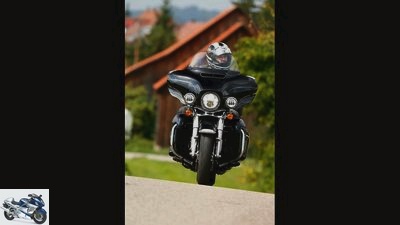
Gargolov
10/24
The fork has not only been retuned, but with a standpipe diameter of 49 millimeters compared to 41 millimeters, it should also have become more stable.
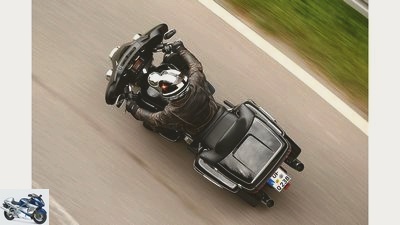
Gargolov
11/24
The pillion offers enough space.
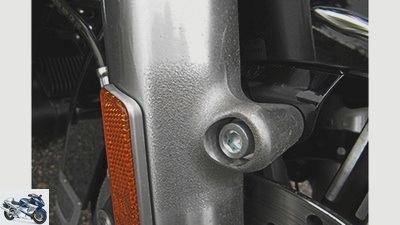
Gargolov
12/24
Basically, the Harley is quite well processed. But for a price of almost 28,000 euros, the fork’s dip tubes should not only be partially, but also completely polished…
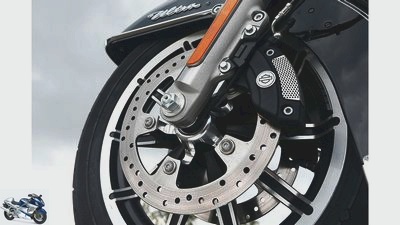
Gargolov
13/24
The Harley-Davidson Electra Glide Ultra Limited is equipped with a fully integral braking system with ABS.
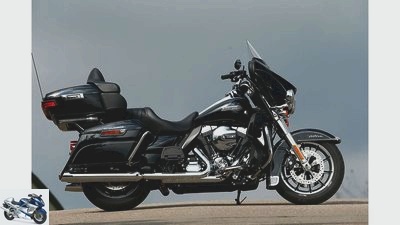
Gargolov
14/24
Sleeker, more pleasing: The design of the 2014 Ultra Limited differs exorbitantly from the previous models without causing a style break.
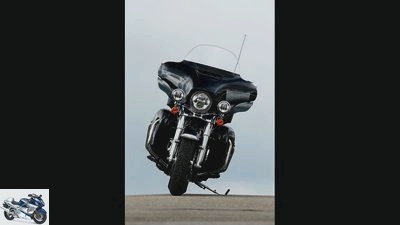
Gargolov
15/24
From the front it makes a pretty beefy impression.
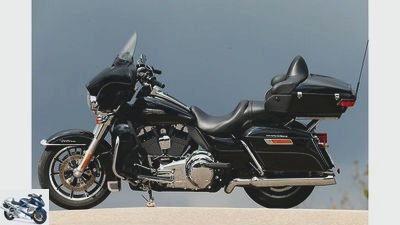
Gargolov
16/24
The redesigned Batwing fairing, the leg shields, the fenders to the topcase – everything is designed to be smoother, more pleasing and more flowing.
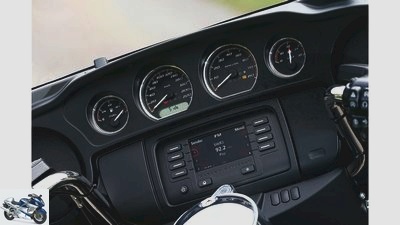
Gargolov
17/24
New command center: tidy, clear, user-friendly with lots of information.
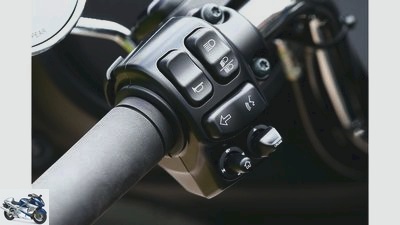
Gargolov
18/24
The control panel on the handlebar of the E-Glide.
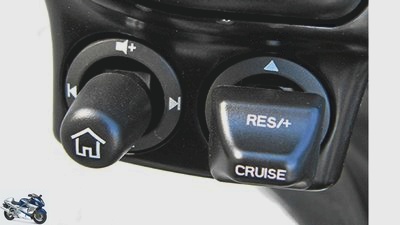
Gargolov
19/24
The new joysticks with which you can control the audio system and cruise control
controls are perfectly positioned, you can control everything with the thumb of your left hand without having to take it off the handlebars.
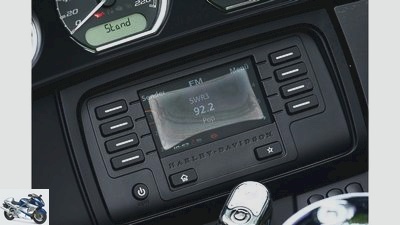
Gargolov
20/24
Water marches in a completely different way: the new display of the audio system fogged up several times over night and even during the test drives, some of which also took place in the rain – that should be improved.
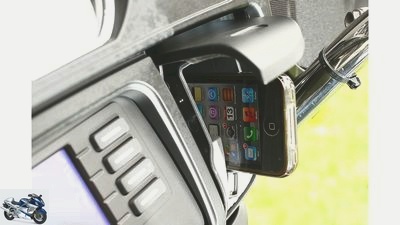
Gargolov
21/24
New compartment: an opening with a USB port for electronic gimmicks is hidden behind a flap in the cladding.

Gargolov
22/24
The LED light is brighter than normal bulbs, but the yield of the
selective high beam disappointed.
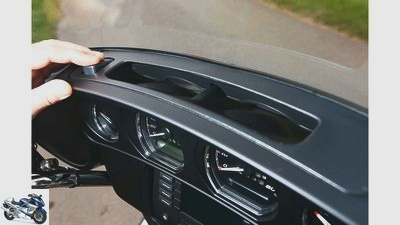
Gargolov
23/24
New gimmick: A flap can be opened at the push of a button, which minimizes the turbulence.
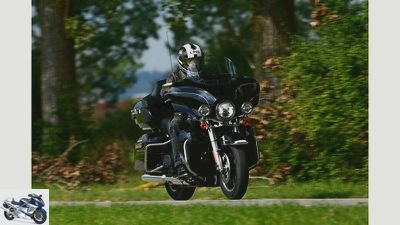
Gargolov
24/24
Overall, the Ultra Limited is better in almost all respects
become than her predecessor.
Top test Harley-Davidson Electra Glide Ultra Limited
Water cooling on Harley’s top tourers
An outcry goes through the fan base: Harley-Davidson has given its iconic air-cooled engine a water-cooling system. Outrage! Blasphemy! Guys stay cool! Not that bad! And the top test clarifies whether the blasphemy might even work devilishly well.
E.s hums! Can this be? 18 degrees outside temperature, five kilometers covered in city traffic, the engine turned off, and now it hums. No ticking that one likes to describe so poetically when cooling fins relax. No, it hums. The cooling system fans run and shovel warm air out of the openings in the leg shields.
Buy complete article
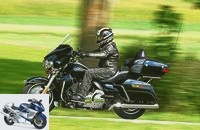
Top test Harley-Davidson Electra Glide Ultra Limited
Water cooling on Harley’s top tourers
Harley-Davidson Electra Glide Ultra Limited. Let’s see how long she does it. Oha, after 45 seconds the fans switch off. What then remains is the much-described ticker.
There is also the certainty that Harley-Davidson will have arrived in the next century and after what feels like three billion years, in which the company had its Big Twins exclusively air-cooled, the E-Glide models are also using water cooling. Why? Comfort, says Harley, so that the riders are not so grilled by the heat from the engine.
The water cooling is basically not as ugly as expected. If only she didn’t make such noises. You can hear it coming, the joke: two E-Glide riders meet. Asks one: "What kind of model do you drive? Hair dryer or grill?" Well, the hair dryer driver could at least answer: "The nicer one."
Because it has become beautiful, the new one, born in 2014. Starting with the newly drawn Batwing cladding to the leg shields, the fenders to the topcase – everything is designed to be smoother, more pleasing and more flowing, without completely breaking with the design language of the last few decades would have. Because an E-Glide was and will always be one of Harley’s icons. With a purchase price from 27,995 euros, the Harley-Davidson Electra Glide Ultra Limited marks the end of the price flagpole, with the exception of the exquisite CVO models. But since beauty is, as always, only in the eye of the beholder, the new one has to convince with performance in the MOTORRAD top test.
More performance thanks to water cooling
Gargolov
Sleeker, more pleasing: the design of the 2014 Ultra Limited differs significantly from the previous models without causing a style break.
First of all, it convinces the test bench: 88 hp at 5100 rpm and 140 Nm at 3900 rpm. These measured values exceed the factory specifications by 3 HP and 2 Newton meters. Compared to the last E-Glide Ultra Limited with the same displacement, which MOTORRAD measured in 2010, the 2014 model has gained almost eight hp and 14 Nm. This is not only remarkable on paper, but is also reflected in the performance: When accelerating from zero to 140 km / h, the 2014 model is 12.1 seconds faster than its older sister. Much more important, however: it is also better in draft. And you can feel that while driving.
That is why we are now leaving the world of data and measured values and swinging into the fluffy saddle, which has also been redesigned. Once in motion, you can only feel the 412 kilograms of the machine at walking pace. And when maneuvering, of course. Maybe in America you should think about going backwards. The mass of motorcyclists is not getting any younger.
Despite its high weight, the Harley looks well balanced, which is certainly also due to the low center of gravity. With a seat height of just 760 millimeters and a relatively narrow waist, even those with short legs can safely reach the floor. Whereby: as a driver you shouldn’t go below 1.60 meters, because you need a certain leg and arm length to park or maneuver the colossus safely.
This is how the Harley-Davidson Electra Glide Ultra Limited drives
Gargolov
Once in motion, the 412 kilograms of US heavy metal can be controlled surprisingly easily.
When the city and its stop-and-go stress are finally behind the wheels, the E-Glide fulfills its purpose. Basically it is the queen of the American interstates, was developed to transport passengers casually and relaxed through the endless expanses of America. But even here in Germany, on motorways, curved country roads or the smallest side roads, it can be cruised well with her. Because the steering behavior is good-natured, you could almost say light-footed.
But only almost. As long as the speed doesn’t drop below 30 km / h, you forget the weight. The machine looks clumsy underneath and requires increased effort to steer. The engine is decidedly casual in almost all situations. It starts at the traffic light – with no other drive in the world it is easier to wait at a red light than with air-cooled Harley twins. Because the engine’s patented pushrod suspension makes the engine fidget entertainingly in the frame. Big cinema. Even without driving.
The tiny water cooling circuit has not changed that. The entertainment continues with the sound: the 2014 model rumbled wonderfully in push mode, and the bass in the airbox can also be heard. In addition, the flap control in front of the silencers makes its contribution in terms of sound: depending on the load, it opens between 3000 and 4000 rpm and enables the gases to escape more uninhibited.
However, this plus in sound is also at the same time a plus in performance that you can feel at medium speeds. The Ultra Limited doesn’t shake robust overtaking maneuvers off its sleeve in a particularly casual way – here it pays tribute to the weight. If you run into an obstacle at 80 km / h and 2000 tours in sixth gear, you sometimes have to shift down two gears for a fiery overtaking maneuver. 80 km / h, fourth gear, 3000 rpm – and quickly over. Never mind. Shifting operations in these engines are still no secret, but at least the gears lock precisely. In general: Anyone who imagines the huge components that work in this mighty, 1690 cubic V2 V2 – the two fat pistons alone cover the distance of 111 millimeters twice per operation – will ultimately be amazed at how smoothly the drive runs. Because the engine does not distribute bad vibrations either on the autobahn at constant speed or on the country road.
Sound without smoke: the "Boom! box"
Gargolov
New compartment: an opening with a USB port for electronic gimmicks is hidden behind a flap in the cladding.
It runs cultivated and comparatively calm, but on the other hand it has retained the rough charm of powerful mechanics. Get off the highway. Up on the freeway. Even when cruising comfortably between 50 and 100 km / h, the small air flap in the fairing, which can be closed by hand, is convincing. When open, it flows behind the windscreen and minimizes turbulence. This works very well up to a speed of 120 km / h, above that only to a limited extent, but still noticeable.
The new audio system that goes by the name “Boom! Box “lives up to its name. The sound is “boom-bastic”. No problem, taking the Ultra out of the garage for a bigger party to fill the dance floor with sound. The menu navigation is simple, the usability with the new joystick is child’s play. This also applies to the operation of the cruise control. In general: The redesigned cockpit is clear, all instruments are easy to read. However, both the time and gear displays are a bit small. On the other hand: Harley riders hardly need either of these anyway. He feels that.
If, on the other hand, he really needed something, it would be reliable brakes with a machine weight of over eight hundred pounds. The new generation of Stopper is at least a light year ahead of its predecessor when it comes to ABS. The two-channel ABS from Bosch, used for the first time, impresses with its very fine control behavior across the board. Simply because of the brakes, it is worth switching from old E-Glides to the 2014 model. When did something like this happen??
The integral brake function, in which the front and rear brakes are electronically linked, is also very useful. Above 40 km / h, the system always activates both brakes, regardless of whether you only brake with your hand or your foot. Depending on the speed or how hard you operate the lever, the braking force is always optimally distributed. In order to decelerate as much as possible, however, both levers – foot and hand – must still be fully used. This is the only way to achieve a deceleration of an impressive 9.2 m / s².
Revisions to the chassis
And finally, the company has also given the chassis an update, because the fork has not only been retuned, but is also said to have become more stable with a 49 millimeter standpipe diameter compared to 41 millimeters. In any case, there is no twisting during extreme braking. In return, it goes to hydraulic block very quickly. Overall, the chassis is very comfortable and transports its guests almost like a litter. If necessary, the rear, air-assisted suspension struts can be made a little harder by inflating air.
In conclusion, it remains to be said: the technicians actually heard the customer’s wishes and implemented them almost in full. This begins with the reduced heat emission from the engine, culminates in better brakes and ends with the one-hand locking of the newly designed case. Perhaps this E-Glide Ultra Limited is even the coolest ever. Also or maybe even because it hums.
Data and measured values
Gargolov
The air / water-cooled two-cylinder four-stroke 45 degree V engine from the E-Glide Ultra Limited.
engine
Air / water-cooled two-cylinder four-stroke 45 degree V-engine, two chain-driven camshafts, two valves per cylinder, hydraulic valve lifters, bumpers, rocker arms, dry sump lubrication, injection Ø 46 mm, regulated catalytic converter, alternator 650 W, battery 12 V. / 28 Ah, hydraulically operated multi-disc oil bath clutch, six-speed gearbox, toothed belt, secondary ratio 2.125.
Bore x stroke: 98.4 x 111.1 mm
Displacement: 1690 cm³
Compression ratio: 10: 1
Rated output: 64.0 kW (87 PS) at 5010 rpm
Max. Torque: 138 Nm at 3750 rpm
landing gear
Double loop frame made of steel, telescopic fork, Ø 49 mm, triangular swing arm made of steel, two spring struts, adjustable spring base, double disc brake at the front, Ø 300 mm, four-piston fixed caliper, disc brake at the rear, Ø 300 mm, four-piston fixed caliper, fully integral brake system with ABS.
Cast aluminum wheels: 3.00 x 17; 5.00 x 16
Tires: 130/80 B 17; 180/65 B 16
Tires in the test: Dunlop front D408, rear D407 T
Mass and weight
Wheelbase 1625 mm, steering head angle 64.0 degrees, caster 170 mm, spring travel f / r 117/76 mm, permissible
Total weight 617 kg, tank capacity / reserve 22.7 / 3.8 liters.
Service data
Service intervals: 8000 km
Oil and filter change: every 8000 km / 3.8 l
Engine oil: H-D 360 SAE 20 / W50
Telescopic fork oil: H-D Fork Oil Type E
Spark plugs: 6R12
Idle speed: 900 ± 100 / min
Tire pressure solo (with pillion passenger) front / rear: 2.5 / 2.8 (2.5 / 2.8) bar
Guarantee: two years
Mobility guarantee: one year
Colors: blue, sand / brown, orange / silver, orange / black, gray / black, gray / silver, red
Price: 27,995 euros
Additional costs: around 490 euros
MOTORCYCLE measurements
BILLION
The engine power of the Harley-Davidson E-Glide Ultra Limited.
Performance
| Top speed * | 175 km / h |
| acceleration | 0-100 km / h: 6.2 sec 0–140 km / h: 12.1 sec |
| Draft | 60–100 km / h: 8.3 sec 100–140 km / h: 11.2 seconds |
| Speedometer deviation | Effective (display 50/100): 49/99 km / h |
| Tachometer deviation | Display red area: 6000 / min Effective: 5900 rpm |
| * Manufacturer information | |
consumption
Country road: 6.1 l / 100 km
Theor. Range of the country road: 372 km
Fuel type: Super
Mass and weight
L / W / H: 2470/970/1470 mm
Seat height: 760 mm
Handlebar height: 1080 mm
Turning circle: 5800 mm
Weight with a full tank: 412 kg
Payload: 205 kg
Wheel load distribution f / r: 44/56%
BILLION
The braking performance of the Harley-Davidson E-Glide Ultra Limited.
Compared to the same, three years older model of the Ultra Limited, the new one is more potent. The partially water-cooled Big Twin generates almost 15 Nm more torque and 8 HP more in the medium speed range compared to the measured model. The Ultra reaches its top speed of 175 km / h in fifth gear, the sixth is a pure overdrive.
The new integral ABS from Bosch decelerates the 412 kg chunk from 100 km / h to a standstill in just under 42 meters. The sensitive control processes are convincing. The ABS regulates the brake force distribution electronically regardless of whether the hand or foot brake lever is operated. This makes perfect sense with this vehicle concept, since the most effective Ver-
deceleration can only be achieved by braking both wheels.
Technology: water cooling in the legendary air-cooled V2
Harley-Davidson, MRD
Only one liter of coolant circulates in a manageable cycle.
Allegedly, Electra Glide drivers around the world complained about the enormous heat radiation in inner-city stop-and-go traffic or during parade drives. The drivers’ legs were literally grilled, so it was said. Because the necessary cooling air flow, which is supposed to conduct the heat away from the engine, arrives only very slowly at low speeds behind the massive cladding.
Basically, according to the manufacturer, all air-cooled motors are thermally completely healthy. From a purely constructive point of view, this step was not necessary. To the delight of the fans, Harley has given it a very nice look. The delicate system is hardly noticeable from the outside, the hoses are well hidden and the coolers are installed almost invisibly in the leg shields. Only one liter of coolant rotates in the circuit and washes around the two thermally highly stressed outlet valves. The electrically driven water pump is protected behind a plastic cover on the frame support.
This scaled-down version of targeted water cooling can also be implemented cost-effectively, because the mold of the cylinder head does not have to be completely redesigned to integrate a cooling coil around the exhaust valve. It is enough to modify the existing one. A desirable side effect of the targeted cooling: the mixture prevents self-ignition and the engine becomes more knock-resistant. In addition, the mixture can be made leaner, which reduces pollutant emissions.
On the other hand, the compression can be increased to generate more power. In the end, that’s what happened: The "Twin Cooled High Output Twin Cam 103" compresses its mixture with 10: 1, its air-cooled brother with only 9.7: 1. The fact that the partially water-cooled twin is not only cooler, but also more effective than its brother, is a nice side effect.
Interview with the Marketing Director Frank Klumpp
Harley-Davidson
Frank Klumpp, Marketing Director Harley-Davidson Germany GmbH, on the introduction of water cooling.
Is partial water cooling an interim solution on the way to fully water-cooled engines?
Klumpp: Harley-Davidson has been building V2 engines since 1909. The liquid cooling of the exhaust valves in our “Twin Cooled High Output Twin Cam 103” in the Electra Glide models “Ultra Classic” and “Ultra Limited” is simply another evolutionary stage of our Big Twin engine. We already have completely liquid-cooled engines: our Revolution engines. All other Harley V-Twins – including the “High Output Twin Cam 103” in the other 2014 Touring models – are air-cooled. As our engineers are innovative, we will continue to comply with legal requirements and offer products that meet the needs of our customers. We are not allowed to reveal what kind of engines will be used in Harley-Davidson motorcycles in the future. But one thing is certain: you will always be as full of character as you rightly expect from our brand.
Was the water cooling necessary?
Klumpp: The liquid cooling of the outlet valves was not necessary. For the customer, it is primarily a convenience feature. Our batwing fairing with leg shields is excellent protection against wind and weather, but in certain situations – such as in traffic jams in midsummer – it helps the driver work up a sweat. With the liquid cooling of the outlet valves, we achieve an ideal situation: The wind and weather protection remains – it was even better in 2014 -, and
we achieve a noticeably lower level of engine heat behind the fairing. In addition, the liquid cooling naturally ensures fewer large fluctuations in the operating temperature of the engine and thus reduced pollutant emissions.
The air-cooled twin-cam engines generally have thermal problems at low speeds?
Klumpp: No, our air-cooled motors were not only tested in the laboratory, but also on the road under the toughest conditions. This also includes extreme situations such as stress tests in particularly hot desert regions. As described above, the liquid cooling is a convenience feature.
Harley-Davidson is considering using dual ignition on all models?
Klumpp: It is part of our company philosophy that we generally do not take a position on future projects or developments.
Due to the increasingly strict emission laws, all Harley models with water cooling will soon have to compete?
Klumpp: We don’t know which emissions requirements we might have to face one day, but we do
convinced that we are currently well prepared for all current and known future requirements.
A current, fully air-cooled 45-degree Harley engine creates the Euro 5 standard?
Klumpp: Our engines are currently designed in such a way that they easily meet the applicable Euro 3 emissions standard. The Euro 4 will not take effect until 2016, the Euro 5 four years later. However, level 5 is currently only provisionally set out in Directive 168/2013 / EC, and the details of this next level will be defined after analysis of a comprehensive environmental study.
We know about the challenges of new regulations and will meet them. Of course, Harley engines will always conform to applicable standards and, to paraphrase Willie G. Davidson, Harley-Davidson will offer air-cooled engines for as long as possible.
Is it technically possible to remove the water cooling from the “High Output Twin Cam 103” later?
Klumpp: That is theoretically possible, but not recommended in practice. For this purpose, you would not only have to replace all relevant engine components, but also reprogram the engine control accordingly. We advise against such a plan!
MOTORCYCLE points evaluation and conclusion
Gargolov
In good hands: behind the batwing fairing, it is cozy and pleasantly relaxed.
| Maximum score |
Harley-Davidson Electra Glide Ultra Limited |
|
| engine | ||
| Draft | 40 | 3 |
| acceleration | 40 | 5 |
| Top speed | 30th | 8th |
| Engine characteristics | 30th | 22nd |
| Responsiveness | 20th | 13 |
| Load change | 20th | 14th |
| Smoothness | 20th | 12th |
| coupling | 10 | 6th |
| circuit | 20th | 11 |
| Gear ratio | 10 | 7th |
| Start | 10 | 8th |
| total | 250 | 109 |
| landing gear | ||
| Handiness | 40 | 12th |
| Stability in turns | 40 | 20th |
| Steering behavior | 40 | 21st |
| feedback | 10 | 4th |
| Inclined position | 20th | 12th |
| Straight-line stability | 20th | 12th |
| Suspension tuning in front | 20th | 12th |
| Chassis set-up at the rear | 20th | 12th |
| Adjustment options undercarriage | 10 | 1 |
| Suspension comfort | 10 | 7th |
| Driving behavior with a passenger | 20th | 15th |
| total | 250 | 128 |
| everyday life | ||
| Ergonomics driver | 40 | 34 |
| rgonomy pillion | 20th | 19th |
| Windbreak | 20th | 18th |
| view | 20th | 9 |
| light | 20th | 15th |
| Furnishing | 30th | 15th |
| Handling / maintenance | 30th | 12th |
| Luggage storage | 10 | 10 |
| Payload | 10 | 7th |
| Range | 30th | 23 |
| processing | 20th | 16 |
| total | 250 | 178 |
| security | ||
| Braking effect | 40 | 28 |
| Brake metering | 30th | 16 |
| Braking with a passenger / fading | 20th | 16 |
| Righting moment when braking | 10 | 8th |
| ABS function | 20th | 14th |
| Handlebar slapping | 20th | 20th |
| Ground clearance | 10 | 7th |
| total | 150 | 109 |
| costs | ||
| guarantee | 30th | 17th |
| Consumption (country road) | 30th | 14th |
| Inspection costs | 20th | 14th |
| Maintenance costs | 20th | 12th |
| total | 100 | 57 |
| Overall rating | 1000 | 581 |
| Price-performance note | 1.0 | 4.0 |
engine
Anyone who expected wonderful things from the well-known two-valve pushrod will be disappointed. The now partially water-cooled V2 runs with little vibration and relatively little noise, hangs cleanly and easily dosed on the gas and pleases with its slightly better performance than its predecessor. The circuit is still precise, but has great travel. The new, now hydraulically operated clutch is not a huge step forward in terms of reduced manual force – it still requires a strong hand.
landing gear
Compared to its predecessor, the new one has gained five kilograms. You don’t really notice that. But especially at low speeds and in tight bends, you struggle with the 412 kilos. On the other hand, the lean angle is pretty decent for a bike of this caliber and the chassis setup for the purpose is also successful, because the suspension was extremely comfortable and can cope with a pillion passenger with a suboptimal body mass index. Above 160 km / h, close to top speed, the machine begins to oscillate easily, but not dangerously.
everyday life
The newly designed bench seat welcomes its passengers in a damn cozy way. It is so well padded that it also absorbs any impacts that the spring elements do not absorb. The new LED headlights cast a brighter, whiter light than their predecessors, but the high beam is too selective. Unfortunately the Limited has neither an (electrically) adjustable disc, nor are hand levers or seat height adjustable. For this reason, the Harley receives few points for equipment. Unfortunately, MOTORRAD does not rate the presence of an audio system any more than its sound.
security
The new Bosch ABS, which controls much, much more sensitively than the system previously used, is a giant step forward. The deceleration is good, as is the dosage, and the brakes remain stable even after repeated extreme braking.
costs
Despite the water cooling, the inspection costs, calculated over a distance of 60,000 km, have not increased. In return, the new one consumes a tad more gasoline than its predecessor.
Price-performance ratio
The price-performance ratio unfortunately does not take into account the stability of the value of the machine, otherwise it would probably be way ahead.
Conclusion
Almost no stone was left unturned – the 2014 model is not only visually, but also technically fit for the future. For Harley conditions and fans, this facelift is almost a sensation, especially because of the cooling circuit. The rest of the world will hardly interest her. Overall, the Ultra Limited has gotten better than its predecessor in almost all respects. Ultimately, there is only one thing missing for luck: a successful diet.
Related articles
-
On the move: Harley-Davidson Electra Glide old versus new
wolf On the move: Harley-Davidson Harley-Davidson Electra Glide old versus new Content of Harley-Davidson is said to sell old technology at modern…
-
Harley-Davidson Electra Glide Ultra Limited in the driving report
Jahn 16 photos Jahn 1/16 After 110 years of history, Harley-Davidson breaks its own tradition with the 45-degree V2 engine. First of all, all touring…
-
Harley-Davidson Electra Glide Ultra Limited and Indian Roadmaster in comparison
Gargolov 28 photos Gargolov 1/28 Harley-Davidson E-Glide Ultra Limited and Indian Roadmaster. Gargolov 2/28 … Electrically adjustable windshield, four…
-
Harley-Davidson Street Glide and Honda Gold Wing F6B put to the test
Gargolov 31 photos Gargolov 1/31 Shortened at the front as if with a scythe, at the back as if compressed with a hammer: excavators look strangely…
-
Comparative test BMW K 1200 LT, Harley-Davidson Electra Glide Ultra Classic, Yamaha XVZ 13 TF Royal Star Venture Beautiful living Eating kilometers, for two, …
-
Harley-Davidson Electra – Street Glide – Brands, Myths and Engines
Gargolov Comparison test: Harley-Davidson Electra / Street Glide Brands, Myths and Engines Pounding V2 bumper engines, heavy metal, archaic technology: a…
-
Harley-Davidson Sportster 883 Iron and Yamaha XV 950 in the test
Gargolov 34 photos Gargolov 1/34 Both cruisers aim high. Which bike is more convincing?? Gargolov 2/34 The point for the feel-good effect clearly goes to…
-
Moto Guzzi MGX-21 and Harley-Davidson Street Glide in comparison test
bilski-fotografie.de 16 pictures www.bilski-fotografie.de 1/16 Not only because of their sheer size, both excavators are more for extroverts …
-
Artistic comparison test naked bikes: BMW R 1150 R Harley-Davidson Dyna Super Glide Sport Triumph Speed Triple Yamaha XJR 1300 Cool and the gang Vier …
-
Harley-Davidson Electra Glide, Honda Gold Wing and Yamaha Vmax
Bilski 48 photos Bilski 1/48 Three rolling icons, sculptures on wheels, celebrate 2015 rounds Birthday. Motorcycles that almost everyone knows, together…